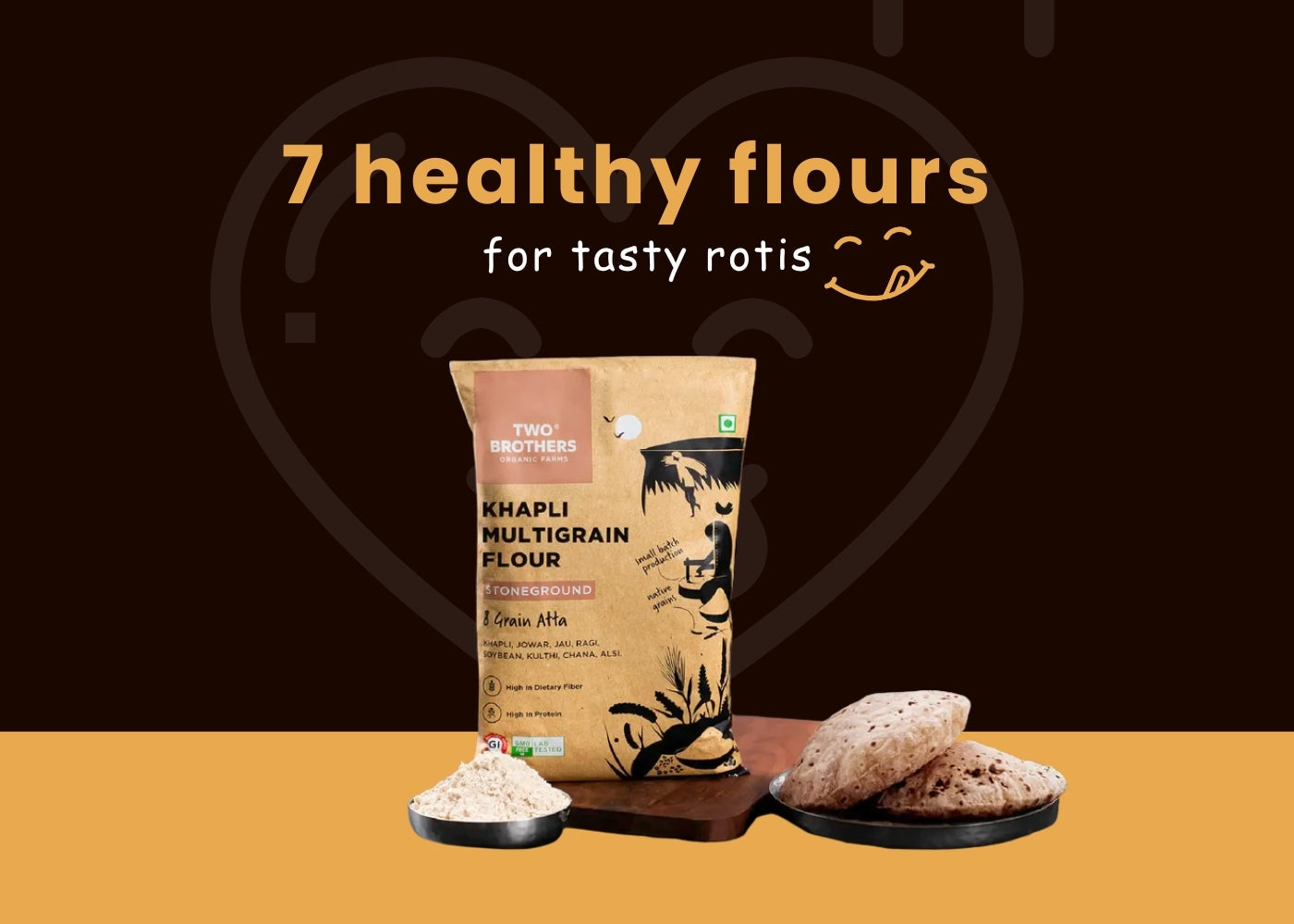Can You Still Enjoy Fresh Rotis Without the Discomfort?
Picture this: you've just finished a delicious meal with warm, fluffy rotis. But within hours, your stomach starts to feel heavy. Bloating sets in. That familiar discomfort returns. If this sounds like your story, you're not alone. Millions of Americans with gluten sensitivity face this daily struggle, torn between enjoying traditional foods and feeling well.
But what if there was a gentler way? What if ancient and traditional wisdom held the answer to this modern problem?
Enter Khapli wheat, an ancient grain offering hope to those caught between gluten sensitivity and their love for wholesome, wheat-based foods. This isn't about trendy diets or complicated substitutes. It's about rediscovering what our ancestors knew: that not all wheat is created equal.
What is Gluten Sensitivity and Why Does It Matter?
Gluten sensitivity, also known as non-celiac gluten sensitivity, affects your body differently than celiac disease. While celiac disease triggers a severe autoimmune response, gluten sensitivity causes uncomfortable symptoms without the same level of intestinal damage.
Common symptoms include:
- Persistent bloating and gas
- Digestive discomfort after meals
- Unexplained fatigue
- Brain fog and difficulty concentrating
- Headaches
- Joint pain
For many people, modern wheat has become harder to digest. Decades of hybridization have created wheat varieties with complex gluten structures that our digestive systems struggle to break down. This is where low-gluten flour alternatives become not just helpful, but life-changing.
Why is Khapli Wheat Different from Modern Wheat?
Khapli wheat, scientifically known as Emmer wheat or Triticum dicoccum, is one of the oldest cultivated grains in human history. Unlike today's heavily modified wheat, ancient grains like Khapli have remained largely unchanged for thousands of years.
The Gluten Structure Makes All the Difference
Modern wheat contains complex gluten proteins that form dense, elastic networks. Khapli wheat flour has a simpler, weaker gluten structure with fewer genetic modifications. This fundamental difference means:
- Easier breakdown during digestion
- Less strain on your digestive enzymes
- Reduced bloating for many with mild sensitivity
- Better nutrient absorption
Think of it like the difference between a tightly woven rope and loose threads – one is much easier to unravel.
Khapli Wheat vs. Modern Wheat: A Side-by-Side Comparison
|
Aspect |
Khapli Wheat (Emmer) |
Modern Wheat |
|
Gluten Content |
Lower gluten, simpler structure |
High gluten, complex structure |
|
Genetic Modification |
Minimal, ancient variety |
Heavily hybridized |
|
Digestibility |
Easier to digest for sensitive individuals |
Often causes bloating and discomfort |
|
Fiber Content |
Higher dietary fiber |
Lower due to refinement |
|
Processing |
Stone-ground, minimal processing |
Highly refined and processed |
|
Nutrient Retention |
Rich in vitamins, minerals, antioxidants |
Many nutrients are lost in processing |
|
Glycemic Index |
Lower GI, steadier blood sugar |
Higher GI, blood sugar spikes |
|
Best For |
Mild gluten sensitivity, health-conscious eating |
General baking, not ideal for sensitivities |
What Are the Health Benefits of Low-Gluten Wheat Flour?
When you choose flour for gluten sensitivity, like Khapli wheat, you're doing more than just avoiding discomfort. You're nourishing your body with what it truly needs.
1. Gentler on Your Digestive System
The simpler gluten proteins in low-gluten flour break down more easily, reducing the workload on your digestive enzymes. Many people who experience discomfort with regular wheat find relief when switching to Khapli wheat.
2. Rich Nutritional Profile
Khapli wheat is packed with:
- High fiber content for gut health and regularity
- Essential minerals, including magnesium, iron, and zinc
- B-complex vitamins for energy metabolism
- Antioxidants that fight inflammation
- Quality protein for tissue repair and muscle health
3. Supports Stable Blood Sugar Levels
The lower glycemic index of low-gluten wheat flour means your blood sugar rises more gradually after meals. This helps prevent energy crashes and reduces cravings throughout the day.
4. Weight Management Friendly
The high fiber content keeps you feeling fuller longer, while the complex carbohydrates provide sustained energy without the blood sugar rollercoaster.
5. Heart Health Support
Ancient grains like Khapli have been associated with better cholesterol profiles and cardiovascular health when consumed as part of a balanced diet.
Can Everyone with Gluten Sensitivity Use Khapli Wheat?
Here's the truth: Khapli wheat is not gluten-free. It's a low-gluten flour option, which means it contains gluten, just less of it, in a simpler form.
Who Can Benefit from Khapli Wheat?
✓ Individuals with mild gluten sensitivity
✓ Those experiencing bloating from modern wheat
✓ People seeking easier-to-digest ancient grains
✓ Health-conscious individuals wanting nutrient-dense options
✓ Anyone looking to reduce refined flour consumption
Who Should Avoid Khapli Wheat?
✗ People with celiac disease (strict gluten-free diet required)
✗ Individuals with severe gluten intolerance
✗ Those with wheat allergies
✗ Anyone advised by their doctor to follow a completely gluten-free diet
Important: If you have celiac disease or severe gluten intolerance, consult your healthcare provider before trying any wheat-based products, including Khapli wheat. For detailed information about Khapli wheat and gluten sensitivity, you can explore this comprehensive guide.
How Can You Use Low-Gluten Flour in Your Kitchen?
The beauty of Khapli wheat flour lies in its versatility. You don't need to learn entirely new recipes or abandon your favorite dishes.
Everyday Uses:
For Traditional Breads:
- Soft, fluffy rotis and chapatis
- Wholesome parathas
- Nutritious puris
For Baking:
- Hearty whole-grain breads
- Muffins and quick breads
- Cookies and crackers
- Pizza dough
For Breakfast:
- Warm porridge
- Pancakes and waffles
- Breakfast bowls
For Savory Dishes:
- Coating for cutlets
- Thickener for gravies
- Dumplings and pasta
Tips for Cooking with Khapli Wheat:
- Start gradually – Mix Khapli flour with your regular flour at first (50:50 ratio)
- Add slightly more water – Khapli dough may need a bit more moisture
- Let the dough rest – Give it 20-30 minutes to hydrate fully
- Use warm water – This helps create softer rotis
- Store properly – Keep in an airtight container in a cool place
Why Choose Two Brothers Organic Farms Khapli Wheat?
Not all Khapli wheat is created equal. The processing method matters tremendously.
At Two Brothers Organic Farms, Khapli wheat undergoes traditional stone-grinding – a method that preserves the grain's natural oils, fiber, and nutrients. This isn't just flour; it's a commitment to authenticity and your wellbeing.
Their Khapli Multigrain Atta combines the goodness of ancient grains with the convenience modern families need. Every batch is:
- Stone-ground using traditional methods
- Chemical-free with no additives or preservatives
- Organically grown on farms that respect the earth
- Minimally processed to retain maximum nutrition
- Lab-tested for quality and purity
This approach honors the grain's heritage while meeting today's health standards.
How Do Ancient Grains Support Overall Wellness?
The shift toward ancient grains isn't just a trend; it's a return to nutritional wisdom. These heritage varieties offer benefits that go beyond low gluten content.
Ancient grains like Khapli wheat have been linked to better weight management due to their:
- Higher satiety factor – You feel full with smaller portions
- Better nutrient density – More nutrition per calorie
- Slower energy release – Sustained fuel without crashes
- Improved gut health – Fiber feeds beneficial bacteria
When you choose low-gluten wheat flour from heritage varieties, you're choosing food that works with your body, not against it.
Making the Gentle Switch to Better Flour
Choosing flour for gluten sensitivity doesn't mean sacrificing tradition, taste, or nutrition. Khapli wheat offers a bridge between modern health needs and ancient nutritional wisdom – proving that sometimes the best solutions have been with us all along.
Your journey toward comfortable, wholesome eating starts with a single choice. When you select stone-ground Khapli wheat from Two Brothers Organic Farms, you're choosing more than just low-gluten flour; you're choosing purity, tradition, and genuine care for your well-being.
Ready to experience the difference? Discover the gentle power of ancient grains and rediscover the joy of eating without discomfort.
FAQs About Khapli Wheat and Gluten Sensitivity
1. Is Khapli wheat completely gluten-free?
No, Khapli wheat is not gluten-free. It's a low gluten flour option with a simpler gluten structure that many people with mild gluten sensitivity find easier to digest. However, it still contains gluten and is not suitable for those with celiac disease or severe gluten intolerance.
2. How much gluten does Khapli wheat contain compared to regular wheat?
While exact percentages vary, Khapli wheat typically contains 30-40% less gluten than modern wheat varieties. More importantly, its gluten structure is simpler and weaker, making it significantly easier to digest for many people.
3. Will I notice a difference in taste when switching to Khapli wheat?
Khapli wheat has a slightly nutty, earthy flavor that many people find more satisfying than regular wheat. The texture is also slightly denser and more wholesome, creating rotis and breads with authentic, rustic character.
4. Can I substitute Khapli wheat flour 1:1 in my regular recipes?
Yes, you can generally substitute Khapli wheat flour 1:1 in most recipes. However, you may need to adjust liquid amounts slightly, as Khapli flour can absorb more water. Start with your regular recipe and add extra liquid if the dough feels too dry.
5. How should I store low-gluten flour to maintain freshness?
Store low-gluten wheat flour in an airtight container in a cool, dry place away from direct sunlight. For a longer shelf life (3-6 months), you can refrigerate or freeze it. Always bring refrigerated flour to room temperature before using it for best results.
6. Can children and elderly family members consume Khapli wheat safely?
Yes, Khapli wheat is safe and beneficial for all ages, provided they don't have celiac disease or severe gluten intolerance. In fact, its nutrient density and easier digestibility make it an excellent choice for children's growth and elderly digestion. Always introduce new foods gradually and observe for any reactions.









